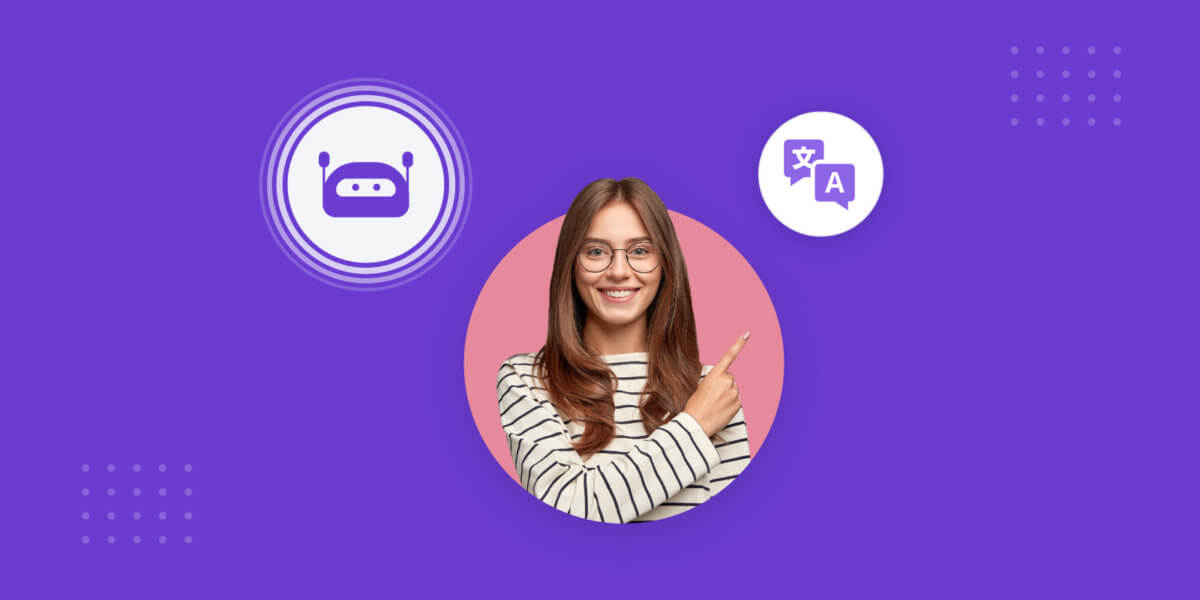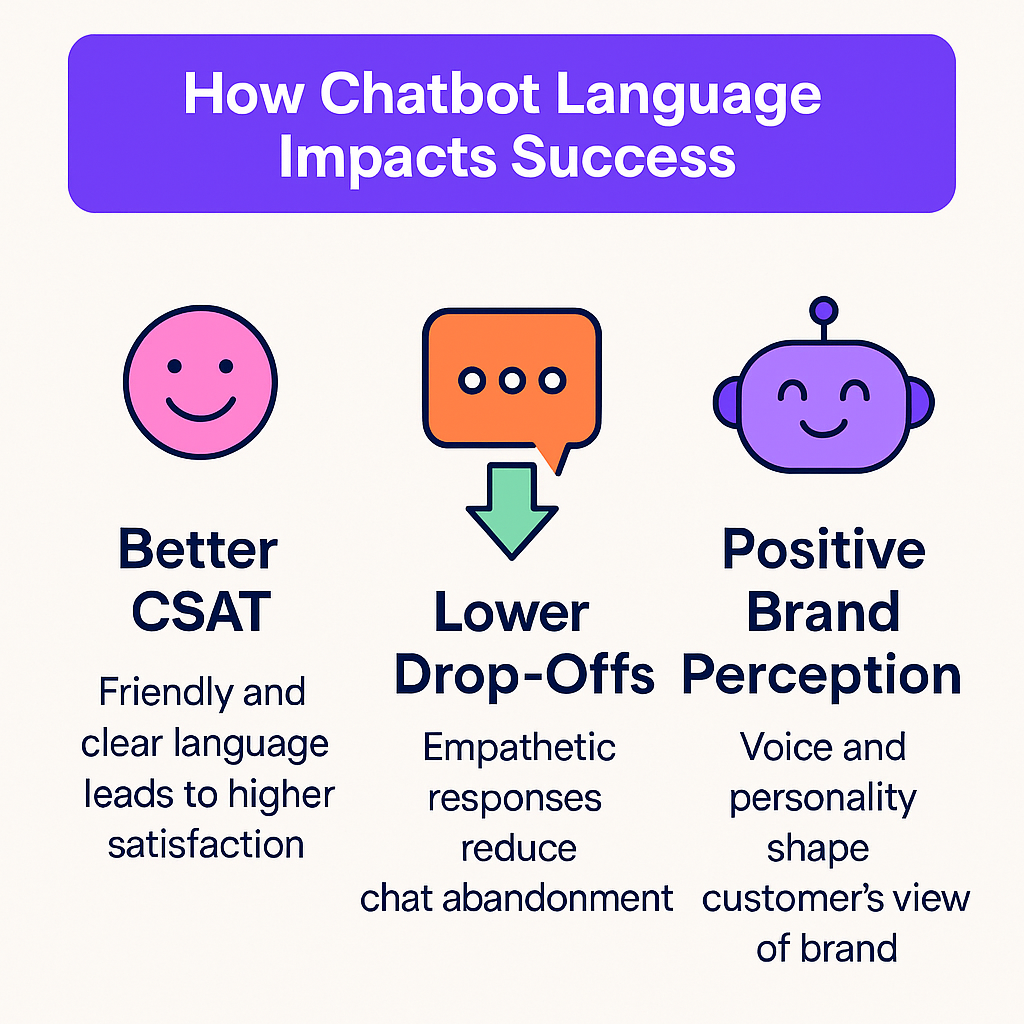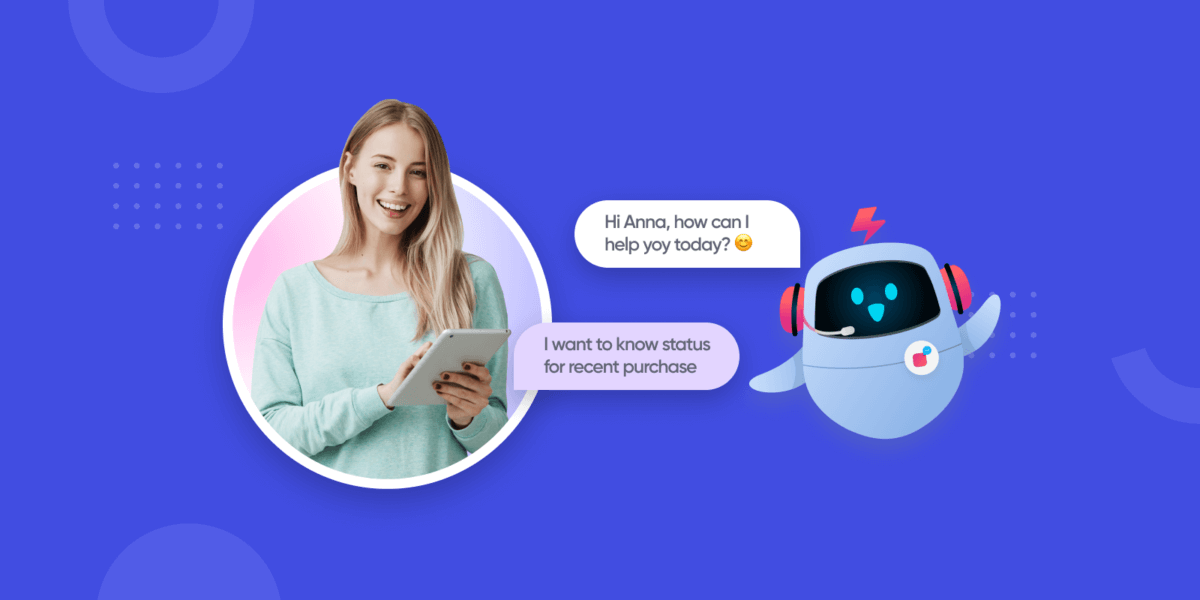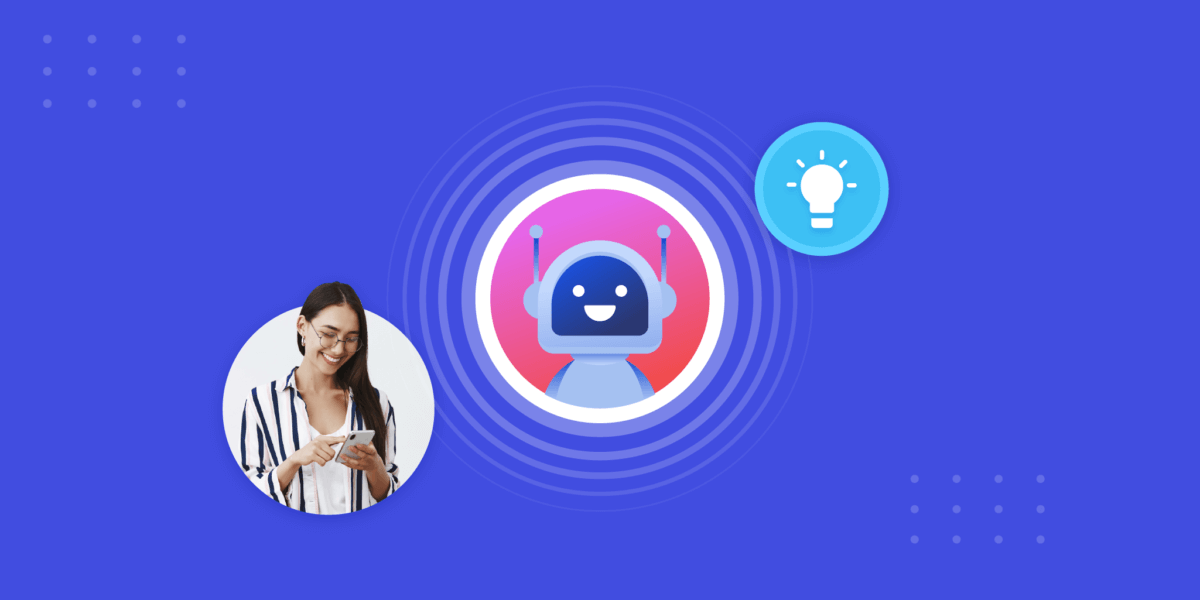
Chatbot 18 – An Indepth Analysis into Chatbot Language
- July 18th, 2025 / 2 Mins read
-
 Aarti Nair
Aarti Nair
Chatbot Language.
This article is the second part of a four-part series called Chatbot 18. Other articles that were published in this series can be found here:
#1: Our Predictions for the Industry
#4: Customer Engagement, Support and Marketing
In this post, we will talk about the chatbot terminology used while discussing chatbots and its future; both short and long-term.
What’s Chatbot Language?
The future is still bright, but it’ll take Verloop some hard-nosed engineering to get there. Chatbots use Artificial Intelligence to run, and the field of AI is equal parts exciting and equal parts bewildering. Various acronyms and words are thrown around and at first glance, it seems they’re all interchangeable with each other. To understand what the future of chatbots holds, let’s familiarise ourselves with three basic acronyms. NLP (Natural Language Processing), NLU (Natural Language Understanding) and NLG (Natural Language Generation).
- NLP, or Natural Language Processing is a blanket term used to describe a machine’s ability to ingest what is said to it, break it down, comprehend its meaning, determine appropriate action, and respond back in language the user will understand.
- NLU, or Natural Language Understanding is a subset of NLP that deals with the much narrower, but equally important facet of how to best handle unstructured inputs and convert them into a structured form that a machine can understand and act upon. While humans are able to effortlessly handle mispronunciations, swapped words, contractions, colloquialisms, and other quirks, machines are less adept at handling unpredictable inputs.
- NLG, or Natural Language Generation, simply put, is what happens when computers write a language. NLG processes turn structured data into text.
Chatbot language isn’t just about what the bot says—it’s how it says it.
It’s the blend of tone, phrasing, clarity, and structure that shapes every interaction between a user and the bot. Think of it as the chatbot’s personality—how it greets, asks questions, responds, and even says goodbye.
At the heart of chatbot language is clarity. Bots should use simple, conversational language. No jargon. No ambiguity. Instead of saying, “Your request has been processed successfully,” a chatbot might say, “Got it! Your order’s on the way.” That small shift makes conversations feel more human.
It also involves consistency in tone—whether your brand voice is playful, formal, friendly, or direct. This tone should be reflected in every part of the conversation, from greetings to error messages.
Most importantly, chatbot language must be context-aware. A well-designed bot adapts how it speaks depending on the user’s history, intent, and even emotional cues. It knows the difference between “I’m angry” and “I’m just frustrated” and tailors its tone accordingly.
With the rise of Generative AI, chatbot language is evolving further. LLM-powered bots can now generate responses that mirror human phrasing, adapt to context mid-conversation, and even match your brand’s tone of voice—making support more natural, and far less robotic.
In short, chatbot language is more than just words—it’s how bots build rapport, earn trust, and keep users engaged from start to finish.
Suggested read: The Essential Chatbot Terminology for Beginners
Why Tone and Personality Matter in Building AI Agents?
Have you ever typed something into a chatbot and instantly felt… disconnected?
Maybe the reply was too stiff—like a legal document. Or worse, it tried too hard to sound cool (“Hey there, bestie!”) while you were filing a complaint about a payment issue.
That’s the difference tone makes.
The way your chatbot speaks is your brand’s voice, digitised. And when the tone doesn’t match the context—or the customer—it breaks trust.
Think about this:
Would you expect a banking bot to say “Oopsie, that didn’t go through 😬”? Probably not.
But for a fashion e-commerce brand, that same tone might feel perfectly on-brand.
Your bot’s language needs to strike the right balance between professionalism and warmth. The tone you use should reflect what your brand stands for, who your users are, and where they are in their journey—whether they’re just browsing or trying to resolve a complaint.
Ask yourself:
-
Is your bot polite and helpful under pressure?
-
Does it sound consistent across support, sales, and feedback flows?
-
And most importantly, does it sound like you?
Because personality isn’t fluff. It’s what keeps the customer from dropping off mid-conversation.
Anatomy of a Good Chatbot Message: Writing Like a Human, at Scale
Great chatbot replies don’t need to be clever or funny. But they do need to be clear, respectful, and purposeful.
Let’s break down what makes a bot message work:
1. Friendly greeting that sets the tone
“Hi Anjali, welcome back! Need help with your recent order?”
→ It’s personal, timely, and shows the bot isn’t starting from scratch.
2. Clear CTA (Call to Action)
“Would you like to reschedule your delivery or speak to an agent?”
→ Options are clear. No guesswork. The user stays in control.
3. Empathetic error message
“Hmm, I didn’t quite get that. Want to try rephrasing or type ‘help’ for options?”
→ The bot acknowledges confusion without blaming the user.
4. Polite escalation when needed
“This seems a bit tricky. Let me get a support agent to assist you further.”
→ No dead ends. No robotic “I don’t understand.” Just a smooth handover.
Your chatbot is often the first voice your customers hear. If that voice is abrupt, vague, or tone-deaf—it reflects on your entire brand. But when done right, even a simple message can reassure, guide, and delight your users.
So before you deploy that new flow, ask:
Would you enjoy this conversation?
Anatomy of a Good Chatbot Message
When was the last time you messaged a brand and felt… understood? Not just replied to, but genuinely heard? That’s what good chatbot copy does—it creates clarity, comfort, and confidence in just a few lines.
Here’s what great bot messages typically include:
Friendly greeting
A warm, personalised welcome sets the tone for the rest of the chat.
Example:
“Hey Ramesh, welcome back! Need help tracking your last order?”
It’s not just polite—it’s smart. A name, a reference to past activity—it shows the bot remembers and cares.
Clear CTA (Call to Action)
A message without direction is just noise. Give users a clear path forward.
Example:
“Would you like to cancel, reschedule, or speak to someone from support?”
Buttons, quick replies, even links—all help steer the conversation smoothly.
Empathetic error message
Bots won’t always get it right. But how they own up to it matters.
Example:
“Hmm, I’m not sure I followed that. Want to try again, or speak to a human?”
Kindness in confusion turns friction into trust.
Polite escalation
When it’s time to bring in the humans, don’t make it feel like defeat.
Example:
“Looks like this needs a human touch. I’m connecting you to a support expert now.”
No cold handoffs. No “I can’t help with that.” Just a seamless transition.
Great messaging doesn’t just answer questions. It makes customers feel heard, even when the answer is “I don’t know, but let me find out.”
Common Mistakes to Avoid: Don’t Sound Like a Bot
Writing for a chatbot isn’t the same as writing emails or social captions. A few missteps can derail the whole experience. Here’s what to watch out for:
Using overly formal or robotic tone
“Your query has been logged and will be addressed in due course.”
Reads like a textbook. Feels like bureaucracy.
Instead:
“Got it! I’ve noted your issue and will keep you updated shortly.”
Sounding too casual in serious contexts
“Oopsie! Your payment failed 😅”
Not ideal when dealing with refunds or failed transactions. Tone needs to match the moment.
Overstuffed or vague messages
“Please ensure that all fields are completed as per the instructions to proceed with the transaction.”
Why not just say: “Please fill in all fields before continuing”?
Less is more—especially on mobile.
Generic responses lacking context
“Sorry, I don’t understand.”
Understand what? What did the customer ask? What can they try next?
A better version:
“Hmm, I didn’t get that. Could you rephrase your question about your recent delivery?”
Your bot has one job: to help, not confuse. Keep it clear, relevant, and human—even if there’s no human behind the screen.
How Generative AI Is Changing Chatbot Language?
Ever chatted with a bot and thought, “Wait, was that… almost human?”
Chances are, that wasn’t a rule-based script—it was powered by Generative AI.
Let’s unpack how large language models (LLMs) like GPT are rewriting the rulebook on chatbot communication.
LLMs craft responses on the fly
Traditional bots rely on scripts. LLMs, on the other hand, generate replies dynamically based on conversation flow, user history, and even emotion.
It’s not just “if user says X, respond with Y.”
It’s more like: “How is the user feeling? What have they asked before? What tone fits the brand right now?”
Personalised replies, tailored tone
Imagine a retail chatbot that cheers you on during a purchase (“That’s a great pick!”), versus a banking bot that stays formal and composed (“Your request has been submitted securely.”).
Generative AI adapts based on:
-
Tone of the user (frustrated, curious, joking)
-
Type of interaction (complaint vs. feedback)
-
Brand voice (fun, empathetic, serious)
It’s like the bot has a tone dial—and knows exactly when to turn it up or down.
Why this matters: Empathy + Context = Better CX
With Gen AI, chatbots can now:
-
Handle edge cases and uncommon questions with smart, relevant replies
-
Use contextual memory to sound more coherent across long chats
-
Show empathy in ways scripted bots can’t (“That sounds frustrating—let’s fix it together.”)
The result? Users feel like they’re speaking with someone, not at a bot.
Hallucinations and tone slips
Generative AI isn’t magic—it has quirks.
-
It can “hallucinate” answers (confidently say something that isn’t true).
-
It may use the wrong tone if brand guidelines aren’t enforced.
-
It might over-apologise, oversimplify, or contradict itself if not fine-tuned well.
This is why grounding your chatbot in structured knowledge (like FAQs, order info, CRM data) and giving it brand tone guardrails is key.
Generative AI is making chatbot conversations more natural, but it’s still learning to walk the line between sounding human and acting responsibly.
Training a Chatbot to ‘Speak Human’
You’ve heard bots speak fluent emoji, some act like Jeeves from the 1920s, and others mimic your brand’s tone so well, you’d think it was your teammate behind the screen.
So, how does that happen?
It starts with the training data
The phrases, responses, and documents you feed your chatbot become its vocabulary and worldview. If your training set includes technical language, the bot may end up sounding like a manual. Include casual FAQs and brand copy? You get a more human touch.
That’s why training a bot isn’t just about accuracy—it’s about style.
Tone-matching matters more than you think
Is your brand witty? Reassuring? No-nonsense?
The chatbot needs to echo that. A finance bot shouldn’t sound like a stand-up comic. A Gen Z beauty brand’s bot probably shouldn’t say “Kindly await further correspondence.”
💡 Ask yourself: Does this sound like us?
Tools that help bots stay on-brand
Platforms like Verloop.io’s Copilot come with tone guidance modules. Think of them like language guardrails—they train the bot on tone, phrasing, and intent.
This ensures every response is on-brand, even if it’s being generated on the fly.
Test. Tweak. Train again.
Just like human agents, bots improve with feedback.
-
Analyse what replies users love (and which they ignore).
-
A/B test new greeting formats or escalation messages.
-
Check tone against live conversations—does it sound warm or robotic?
Iterating on language is how you go from “meh” to memorable.
How Chatbot Language Affects Key Metrics
Words matter. And when it comes to chatbot performance, language impacts more than just tone—it directly moves the needle on business metrics.
CSAT and NPS get a boost
When bots sound clear, kind, and competent, customers are more likely to leave a high satisfaction score. And when they feel heard? That reflects in Net Promoter Scores (NPS), too.
Friendly tone + fast help = better sentiment = better scores.
Fewer drop-offs in first-touch replies
Ever abandoned a chat because the first reply made no sense—or sounded like a robot from 2005?
An empathetic, well-worded response encourages users to stay. It invites interaction rather than deterring it.
More resolutions, more engagement
Clear language reduces back-and-forth. Bots that understand and respond naturally help solve queries faster.
That means more issues resolved in-chat—and fewer frustrated escalations to human agents.
Your brand voice = your bot’s personality
Let’s be honest—your chatbot may be the first (and most frequent) interaction someone has with your business.
And what they hear?
That becomes your brand voice.
Make it count.
What’s the Future Like?
As Verloop keeps bettering the underlying technology through trial and error, NLP will grow more efficient, capable of handling more complex commands and delivering more poignant outputs.
Chatbots will also be able to have multi-linguistic conversations. They will not only be able to understand hybrid languages like ‘Hinglish’ (Hindi and English) with NLU, but with advanced NLG, will also be able to reciprocate in kind.
But how can simple code assimilate something as complex as speech in only the span of a handful of years? It took humans hundreds of generations to identify, compose and collate the English language. Chatbots have a one up on humans, because of the way they dissect the vast data given to them. Now that we have a grip on the basics, we’ll understand how chatbots work in the next series.
Your Chatbot Speaks Volumes—Make It Count
When a customer chats with your bot, they’re not just looking for answers—they’re forming impressions. And what your chatbot says, how it says it, and the tone it uses shapes your brand’s personality.
Language isn’t just a means of communication—it’s connection. Whether it’s reassurance during a payment failure or enthusiasm in a product recommendation, the right words make all the difference.
So here’s a simple ask: audit your bot’s tone. Is it clear? Friendly? Does it sound like you? Or just like every other chatbot out there?
Ready to Make Your Chatbot Sound Human?
Let Verloop.io show you how. With advanced tone control, generative AI guidance, and tools like Copilot, you can train your chatbot to speak in a way that resonates with your customers—and boosts your CX metrics.
👉 Book a free demo and hear the difference.
FAQ
Q: What’s the difference between chatbot scripts and chatbot language?
A: Scripts are pre-written responses for specific scenarios. Chatbot language refers to the overall tone, personality, and linguistic style used in those responses—whether scripted or dynamically generated.
Q: Can I customise my chatbot’s tone to match my brand?
A: Absolutely. With platforms like Verloop.io, you can tailor tone, language style, and even set up tone rules using tools like Copilot for consistent messaging.
Q: Do generative AI bots always follow tone guidelines?
A: Not by default. They need guardrails—like fine-tuned models, tone instructions, and real-time moderation—to ensure responses stay on-brand. Without them, responses may sound inconsistent.
Q: What’s the best tone for an e-commerce vs. a BFSI chatbot?
A: For e-commerce: friendly, helpful, casual works well. For BFSI (Banking, Financial Services, Insurance): clarity, professionalism, and empathy are key. The tone should match user expectations and regulatory standards.







